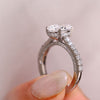
Yellow Gold vs White Gold Jewelry: What’s the Real Difference?
Gold vs White Gold Jewelry has long been a symbol of luxury, beauty, and timeless elegance. But when it comes to choosing gold jewellery, the decision often goes beyond just style it’s about selecting the right type of gold that suits your taste, lifestyle, and even skin tone. Two of the most popular choices are yellow gold and white gold. Both are made from real gold and often feature similar levels of purity, yet they look very different and behave differently over time.
Yellow gold offers a rich, warm tone that evokes tradition and vintage charm. It’s often associated with heritage pieces, classic bridal jewellery, and royal-inspired styles. On the other hand, white gold brings a cooler, modern aesthetic that many find sleek and sophisticated, making it a go-to for contemporary engagement rings and fashion-forward accessories.
But it’s not just about looks. Each type of gold has its unique composition, care needs, durability, and price points, all of which can influence your decision. Whether you're investing in a custom engagement ring, a pair of earrings, or a timeless pendant, knowing the real difference between yellow and white gold can make all the difference.
What Is Yellow Gold?

Yellow gold is the most traditional and naturally occurring form of gold used in jewellery. Its rich, warm hue has symbolised luxury and romance for centuries from ancient royal adornments to classic wedding bands.
Pure gold (24 karat) is naturally yellow, but it’s too soft for everyday wear. To create durable jewellery, it is mixed with other metals such as copper and silver. These alloy metals not only enhance the strength of the gold but also help maintain its signature golden colour.
Common purities used in yellow gold jewellery include:
- 18K gold (75% gold + 25% alloy)
- 14K gold (58.3% gold + 41.7% alloy)
The higher the karat, the more vibrant and softer the gold will be but it may also be more prone to scratching. Yellow gold is often chosen for its classic appearance, hypoallergenic properties, and ease of maintenance, as it doesn’t require rhodium plating like white gold does.
What Is White Gold?

White gold is a popular modern alternative to yellow gold, known for its cool, silvery-white appearance that closely resembles platinum or silver. It’s a stylish choice for engagement rings, wedding bands, and contemporary jewellery lovers who prefer a sleek and elegant finish.
White gold is not a naturally occurring metal it’s made by mixing pure yellow gold with white metals such as palladium, nickel, or silver. This blend lightens the gold’s colour and increases its strength. To enhance its bright, reflective finish, most white gold jewellery is plated with rhodium, a rare and durable metal from the platinum family. This rhodium coating gives white gold its brilliant shine and also adds a layer of protection against scratches and tarnishing.
White gold commonly comes in:
- 18K white gold (75% gold + 25% white metals)
- 14K white gold (58.3% gold + 41.7% white metals)
Over time, the rhodium plating may wear off with regular use, causing the piece to reveal a slightly yellowish tint underneath. To maintain its bright white finish, it’s often recommended to have the jewellery replated every few years.
Appearance and Style Differences

When it comes to visual appeal, yellow gold and white gold each bring a unique style and personality to your jewellery. Your choice often depends on aesthetic preference, fashion sense, and how the metal complements your skin tone or gemstone.
Yellow Gold: Warm, Classic, and Vintage-Inspired
Yellow gold has a rich, warm tone that gives off a traditional and romantic feel. It's often associated with vintage and antique styles, making it a favourite for heirloom pieces, intricate settings, and timeless engagement rings. Its warm hue pairs beautifully with coloured gemstones like emerald, ruby, and sapphire, as well as Moissanite stones with warmer undertones.
- Ideal for: Traditional, boho, or vintage-inspired designs
- Complements: Medium to darker skin tones or warm undertones
- Popular in: Classic wedding bands, antique-style rings, and royal-inspired jewellery
- White Gold: Cool, Sleek, and Modern
White gold features a crisp, silvery-white finish that looks contemporary and polished. It’s a perfect match for modern and minimalist designs, and is often preferred for solitaire settings or halo rings where the metal allows the stone to stand out sharply, especially in the case of lab-grown Moissanite or colourless gems. Its platinum-like finish offers luxury without the premium cost.
- Ideal for: Contemporary, clean-lined, or understated styles
- Complements: Fair to medium skin tones or cool undertones
- Popular in: Modern engagement rings, fashion-forward bands, and fine jewellery sets
Durability and Everyday Wear

When it comes to durability, both yellow gold and white gold have strengths but they perform differently depending on purity and daily use.
Yellow Gold
- Softer metal, especially in higher karats (e.g. 22K).
- Prone to scratches and bending if worn daily, particularly in rings.
- Better suited to occasional wear or lower-karat options like 14K for more durability.
White Gold
- Made by mixing gold with stronger white metals (like nickel or palladium), making it harder and more scratch-resistant than yellow gold.
- Coated in rhodium, which gives it that bright, reflective finish and adds extra protection.
- The rhodium layer wears down with time and may need re-plating every 1–2 years, especially with daily wear.
Maintenance and Care

While both Gold vs White Gold Jewelry are beautiful and durable, they require different care routines to keep them looking their best over time. Understanding how each metal behaves with daily wear will help you make a smart choice especially for pieces like engagement rings or wedding bands that are worn every day.
At Diamondrensu, we celebrate the beauty and craftsmanship behind every piece of jewelry, especially when it comes to the timeless appeal of yellow gold and the sleek charm of white gold. Both metals have their own distinct personality, offering something special to suit every style and occasion. Gold vs White Gold Jewelry radiates a rich, inviting glow that has enchanted generations.
White gold offers a modern twist on classic gold, with a lustrous silvery finish that rivals platinum’s elegance at a more accessible price. Its cool, reflective surface beautifully showcases colourless and near-colourless stones, making it a popular choice for engagement rings, wedding bands, and statement pieces.
Conclusion

Choosing between Gold vs White Gold Jewelry ultimately comes down to personal style, lifestyle, and how you want your pieces to express your individuality. Yellow gold offers timeless warmth and classic elegance, perfect for those who appreciate tradition and rich tones. Meanwhile, white gold delivers a modern, sleek look with its cool silvery sheen, ideal for contemporary tastes and showcasing sparkling stones.
Both metals have their strengths and care considerations, but with proper maintenance, they can remain beautiful for a lifetime. Whether you prefer the glowing heritage of yellow gold or the sophisticated shine of white gold, your jewellery will be a cherished reflection of you.
FAQS
1. What is the main difference between yellow gold and white gold?
Yellow gold is the natural colour of pure gold with warm tones, while white gold is yellow gold alloyed with white metals like palladium or nickel and coated with rhodium for a silvery finish.
2. Which is more durable: yellow gold or white gold?
White gold tends to be slightly more durable due to the alloys mixed with it, but both are strong enough for everyday wear when crafted with the right karat and care.
3. Does white gold require special maintenance?
Yes, white gold is typically rhodium plated to enhance its shine, and this plating may wear off over time. It needs to be replated every 1–2 years to maintain its bright white appearance.
4. Is yellow gold hypoallergenic?
Yellow gold, especially in higher karats like 18K, is usually hypoallergenic, but alloys in lower karat gold or white gold (which may contain nickel) can cause allergic reactions in sensitive skin.
5. Which gold colour suits my skin tone best?
Yellow gold complements warm, olive, and darker skin tones, while white gold looks great on fair to medium skin with cool undertones.
Leave a comment
Please note, comments must be approved before they are published.









